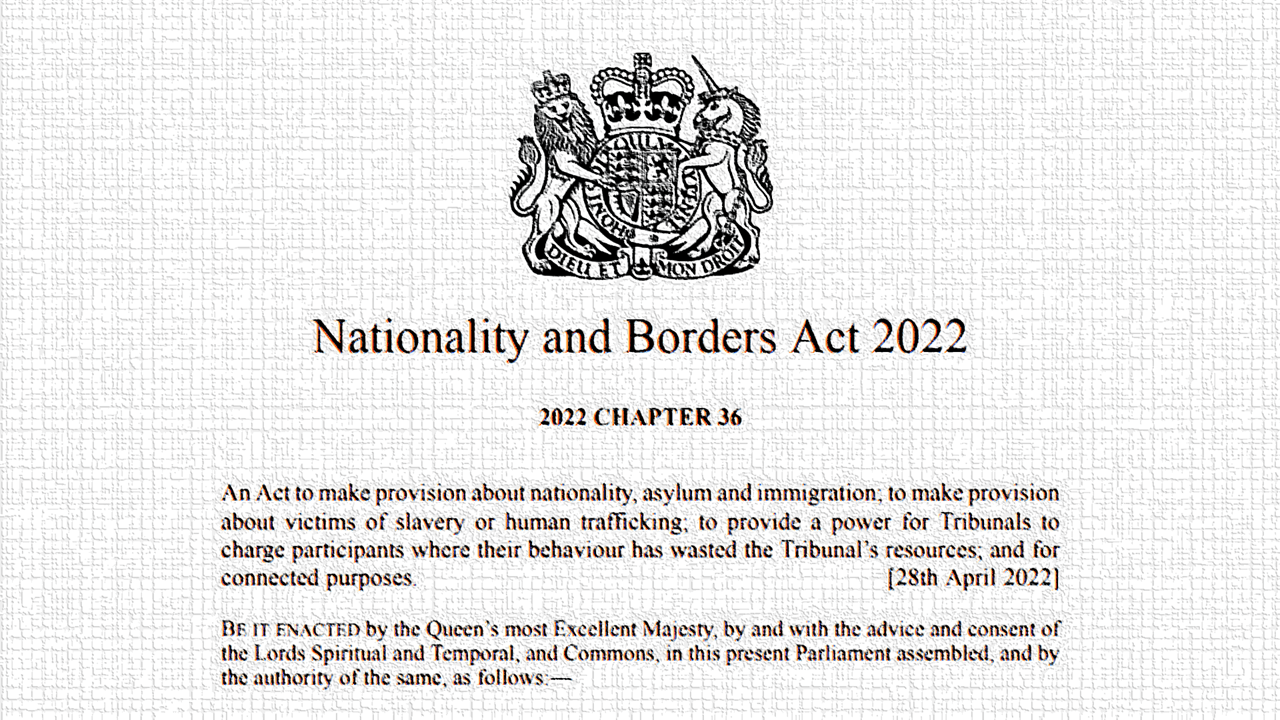The Nationality and Borders Act 2022 (the Act) is a unique piece of legislation with far-reaching consequences.
Background
In March 2021, the UK government published the ‘New Plan for Immigration Policy Statement’.
In their statement, they said:
‘We have taken back control of our legal immigration system by ending free movement and introducing a new points-based immigration system. The UK now decides who comes to our country based on the skills people offer, not where their passport is from. That is how we are addressing the need for clear controls on legal immigration.
But to properly control our borders we must address the challenge of illegal immigration too’.
The Nationality and Borders Act 2022 was their response.
On 6 July 2021, the UK government introduced the Nationality and Borders Bill to the House of Commons. The bill received royal assent and became law on 28 April 2022.
How Does a Bill Become a Law?

A bill is a proposal for a new law. Sometimes it can be a proposal to change existing law. The UK government presents a bill for debate before Parliament.
A Bill can start in the House of Commons or the House of Lords.
When it starts in the House of Commons, it should go through the following 12 steps:
- Formal Introduction/ First Reading. Usually, this stage is a mere formality. It takes place without debate.
- Second reading. This is where the MPs have their opportunity to debate the general principles and themes of the Bill. At the end of the debate, the Commons votes if it can proceed to the next stage.
- Committee stage. This stage is called the ‘committee’ stage because only a Public Committee can examine the bill at this stage. At this stage, experts and interest groups from outside Parliament can give evidence and share views. Then the committee amends the Bill and prints it off for all MPs to examine.
- Report stage. At this stage, MPs can make further amendments and vote for them to be included in the Bill.
- Third reading is the final chance for the MPs to discuss the sections of the future act. However, they cannot make amendments at this stage – they can only vote on whether to approve the third reading.
After third reading at the House of Commons, the bill is sent to the House of Lords, where the bill has a similar journey:
- First reading (Lords)
- Second reading (Lords)
- Committee stage (Lords)
- Report stage (Lords)
- Third reading (Lords)
After the third reading at the House of Lords, the bill returns to the House of Commons. This stage is known as:
- Consideration of amendments. At this stage, both Houses need to agree on the exact wording of the bill. If the House of Commons makes amendments to the bill, the House of Lords needs to accept them. The bill may go back and forth a few times (some call it a ‘ping pong’ stage).
- Royal Assent. After the Commons and Lords agree on the final version of the bill, it receives Royal Assent and becomes an Act of Parliament
In case you are curious about what happens if the two Houses do not reach an agreement – the ‘bill falls’. However, in certain circumstances, the House of Commons can still pass the bill.
The Idea Behind the Act
Priti Patel said that the Act would, first of all, deter illegal entry into the UK.
The UK government hopes to achieve this by breaking the business model of people-smuggling networks. They’ll also speed up the removal of those with no right to be in the UK.
This, in their view, will hopefully lead to freeing up the asylum system. As a result, the UKVI hopes to be in the position to support those in genuine need of asylum through safe and legal routes.
The Act also concentrates on matters relating to the British overseas territories’ citizenship and registration of stateless citizens.
Additionally, the Act gave the Government new powers when considering applications from victims of modern slavery. It has clauses that limit support where the applicants did not provide evidence of their abuse within the time given to them.
The Uniqueness
The Nationality and Borders Act makes wide changes to the UK asylum system.
Rather unprecedently, the Act introduces ‘designated places’. Some of these places can be ‘offshore’ asylum hubs. In other words, an asylum seeker can now potentially submit their refugee and migrant asylum claims in another European or an African country.
Also, the Act introduces a two-tier asylum system. In practice, this means that those who choose to arrive in the UK via irregular means are likely to receive less protection and support.
The Act increased the standard of proof for establishing someone is a refugee. It also reduced the threshold at which someone is considered to have committed a particularly serious crime. If this happens – the applicant will not get refugee protection.
The Act removes stages of appeal or fast-tracks certain cases. Furthermore, it imposes penalties for late submission of evidence.
Also, the Act gives the Immigration Tribunal additional powers to fine lawyers for improper, unreasonable or negligent behaviour.
The Structure
The Act consists of 7 parts and 8 schedules:
Parts:
- Nationality
- Asylum
- Immigration Control
- Age Assessments
- Interpretation
- Miscellaneous
- General
Schedules:
- Waiver of requirement of presence in UK etc
- Deprivation of Citizenship without notice: judicial oversight
- Expedited appeals where priority removal notice served: consequential amendments
- Removal of asylum seeker to safe country
- Penalty for failure to secure goods vehicle etc
- Working in United Kingdom waters: consequential and related amendments
- Maritime enforcement
- Prisoners returning to the UK: Modifications of Criminal Justice Act 2003
